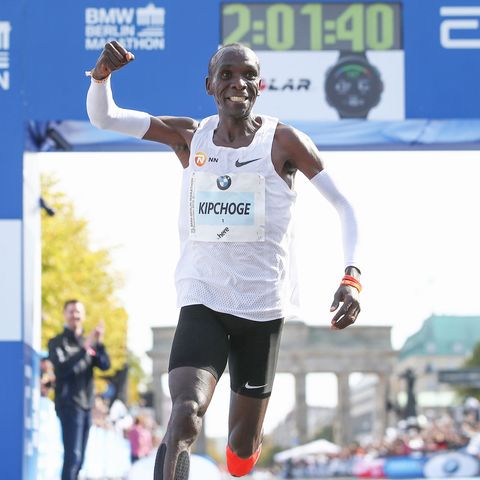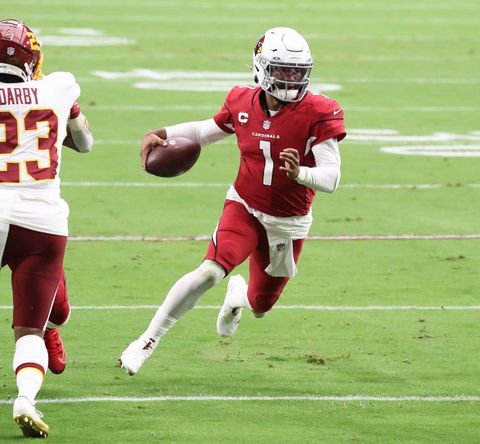These 4 Athletes Are the Future of Their Sports
The prototypical standard of what makes an elite athlete might be morphing. Conventional thinking will have you believe that success in sports will come when one side is bigger and stronger than the competition—but there’s more to winning games, matches, and races than overwhelming force.
Since today’s high-level sports stars are starting to target more nuanced forms of training and perfecting the subtler tools of their athletic arsenals more than their predecessors, their paths to success might look different than in years past. That means that the dominant athletes of tomorrow might literally look different than what we expect in our sports idols today.
From a quarterback who uses his small frame and speed as a near unstoppable weapon to a near 7-foot position-swapping two-time NBA MVP, these athletes are redefining what tools it takes to have success on the highest stages of sports.

The Game-Changing Sports Stars
Eliud Kipchoge
5’6″, 115 pounds
First man to run a sub two-hour marathon (that’s 4-minute, 35-second per mile pace).

Not since the four-minute mile has there been an endurance goal so elusive as the two-hour marathon. Kipchoge partnered with Nike and showed the world that exploring the farthest extremes of human performance requires intense and elaborate planning.
The course needed to be relatively flat, without curves, at sea level, and its temperatures had to be between 45 and 57 degrees Fahrenheit with humidity below 80 percent—optimal gradients and weather to drop the hammer. And once the starting gun fired, five pacers who formed a V shape ran directly in front of Kipchoge, while two other pacers ran behind him forming a smaller V. This lopsided hourglass formation allowed Kipchoge to maintain the perfect pace and also cut wind resistance. His also wore a bespoke version of the Nike Vaporfly, shoes that were designed to help him run faster.
Because of these big assists, Kipchoge’s time of 1:59:40 won’t be counted as an official record. But now that that the psychological barrier of a sub-two is broken, expect others to achieve the same in a race in the next five to ten years—with fewer assists.
Steal a Move
You can orchestrate your own marathon PR—and perhaps qualify for Boston. Selecting a marathon that has a net elevation loss can speed your time. Checkout the Mesa Marathon, in Arizona, or the Revel Mount Charleston Marathon, in Las Vegas.
This type of course hacking will help, but you’ll also need to put in the miles. Kipchoge ran up to 140 miles per week in training for his record run. For the average runner, more miles equates to a faster marathon. Data from 27,000 users of the app RunKeeper shows that people who logged 38 to 44 training miles a week finished their marathon about an hour faster than those who logged six to thirteen weekly miles. Don’t just go from couch to 50K. Research conducted in Denmark suggests that increasing your mileage by 10 percent or less each week allows you to build endurance with less risk of injury.
Kyler Murray
5’10″, 207 pounds
2019 NFL Draft 1st Overall Pick

Murray—all 5’10”, 200 pounds of him—is the latest step in the NFL’s continuing quarterback revolution, which has shifted from Brady-like pocket passers to run-pass threats. To survive in the NFL, Murray must combine speed and strength, and have plenty of speed. His 4.38 40-yard dash and 20.1 MPH max speed is among the fastest in the league.
Steal a Move
One of the best ways for smaller guys to get stronger and faster is to combine explosive compound lifts with sport-specific sprints, says Ed Napper, a New York City-based trainer. Murray spent the 2020 offseason performing fast-paced lower body lifts. He kept his reps at 4 to 6 seconds each—the time of an average NFL play—and rest periods at 40 seconds—the length of an NFL play clock. Those were followed by sprint work. He’d log about 100 total yards of sprinting in 10 to 15-yard increments.
Napper suggests you do the same: Warmup with some light cardio for 12 minutes. Then do seven reps of barbell or kettlebell front squats, leaving two reps in the tank, then immediately sprint for 30 seconds. Rest for one minute. That’s one round. Do three.
Bryson DeChambeau
6’1”, 235 pounds
2020 US Open winner re-inventing golf fitness

“Golf training has a reputation for corrective bands and fluffy balance exercises,” says Jim Ferris, C.S.C.S., a Philadelphia-based trainer who works with pro athletes. Dechambeau’s approach, meanwhile, is more freshman linebacker trying to bulk up for the season. He spent quarantine adding 40 pounds to his frame through a combination of lifting heavy and often, and eating a lot of meat.
DeChambeau is now 50 percent heavier than competitors like Rory McIlroy. As a result, he saw his average drive jump to 322 yards, the longest on the PGA Tour, and started 2nd in the FedEx Cup in 2021. “Golf is a rotational power sport,” says Ferriss. “He’s training properly to put maximal power into the ball.”
Steal a Move
More muscle can power longer drives by allowing you to put more force into the ground and transfer power into the ball. “But weight being added for performance needs to be measured,” says Ferris. Extra muscle can’t come at the expense of restricted movement. “For every 2 or 3 pounds of muscle you gain, make sure that you’re maintaining rotational range of motion and are seeing your strength go up,” says Ferris.
To add mass and power, do three sets of 10 reps of trap bar deadlifts, and 3 sets of 5 rotational medicine ball throws at least twice a week. Each time your scale weight rises, test your range of motion with the side-lying windmill. If your mobility drops, stay at your current weight until your mobility returns.
Giannis Antetokounmpo
6’11”, 242 Pounds
NBA 2X MVP, 2X Defensive Player of the Year, 4X All Star
Lakers vs Bucks, December 19th 2019. LeBron and Anthony Davis can render any big man moot. But Antetokounmpo is a big redefining what a big can do. He played every position—driving, working the perimeter, posting up—and racked up 34 points (15 of them from three point shots), 7 assists, 11 rebounds, and a steal and block. Antetokounmpo displays this sort of versatility and ownership of stat lines nightly, making him the freakiest, most unstoppable player in the game.
Steal a Move
Despite his range on both ends, the Greek Freak is at his most comfortable (and most impressive) when he powerfully drives, penetrates, and posterizes. That type of explosiveness is driven by pure hip power, which Antetokounmpo builds with heavy hip thrusts. And we mean, like, 570 pounds heavy.
Try low-rep sets of hip thrust to build Freak power: Sit on the ground, heels near your butt, shoulder blades on a bench or box, a loaded barbell on your hips. Looking straight forward, tighten your abs, then raise your hips so they’re touching the bar. Now thrust your hips up, squeezing your glutes at the top. Your feet should be flat on the ground and knees bent about 90 degrees. Lower the weight. That’s one rep, do 4 sets of 5.
A version of this story originally appears in the TK ISSUE of Men’s Health, with the title “THE FUTURISTIC ATHLETES”.
Source: Read Full Article

